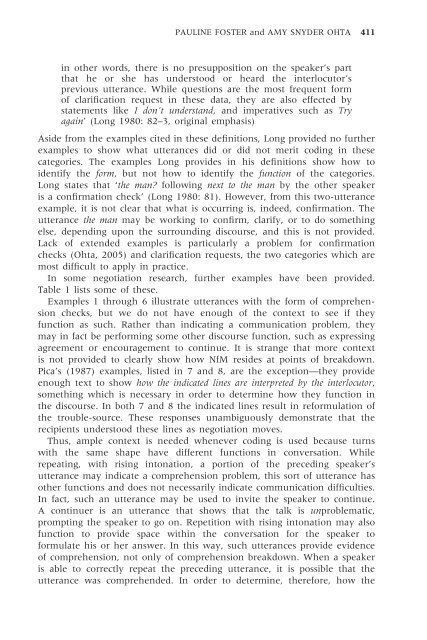Negotiation for Meaning and Peer Assistance in Second Language ...
Negotiation for Meaning and Peer Assistance in Second Language ...
Negotiation for Meaning and Peer Assistance in Second Language ...
You also want an ePaper? Increase the reach of your titles
YUMPU automatically turns print PDFs into web optimized ePapers that Google loves.
PAULINE FOSTER <strong>and</strong> AMY SNYDER OHTA 411<br />
<strong>in</strong> other words, there is no presupposition on the speaker’s part<br />
that he or she has understood or heard the <strong>in</strong>terlocutor’s<br />
previous utterance. While questions are the most frequent <strong>for</strong>m<br />
of clarification request <strong>in</strong> these data, they are also effected by<br />
statements like I don’t underst<strong>and</strong>, <strong>and</strong> imperatives such as Try<br />
aga<strong>in</strong>’ (Long 1980: 82–3, orig<strong>in</strong>al emphasis)<br />
Aside from the examples cited <strong>in</strong> these def<strong>in</strong>itions, Long provided no further<br />
examples to show what utterances did or did not merit cod<strong>in</strong>g <strong>in</strong> these<br />
categories. The examples Long provides <strong>in</strong> his def<strong>in</strong>itions show how to<br />
identify the <strong>for</strong>m, but not how to identify the function of the categories.<br />
Long states that ‘the man? follow<strong>in</strong>g next to the man by the other speaker<br />
is a confirmation check’ (Long 1980: 81). However, from this two-utterance<br />
example, it is not clear that what is occurr<strong>in</strong>g is, <strong>in</strong>deed, confirmation. The<br />
utterance the man may be work<strong>in</strong>g to confirm, clarify, or to do someth<strong>in</strong>g<br />
else, depend<strong>in</strong>g upon the surround<strong>in</strong>g discourse, <strong>and</strong> this is not provided.<br />
Lack of extended examples is particularly a problem <strong>for</strong> confirmation<br />
checks (Ohta, 2005) <strong>and</strong> clarification requests, the two categories which are<br />
most difficult to apply <strong>in</strong> practice.<br />
In some negotiation research, further examples have been provided.<br />
Table 1 lists some of these.<br />
Examples 1 through 6 illustrate utterances with the <strong>for</strong>m of comprehension<br />
checks, but we do not have enough of the context to see if they<br />
function as such. Rather than <strong>in</strong>dicat<strong>in</strong>g a communication problem, they<br />
may <strong>in</strong> fact be per<strong>for</strong>m<strong>in</strong>g some other discourse function, such as express<strong>in</strong>g<br />
agreement or encouragement to cont<strong>in</strong>ue. It is strange that more context<br />
is not provided to clearly show how NfM resides at po<strong>in</strong>ts of breakdown.<br />
Pica’s (1987) examples, listed <strong>in</strong> 7 <strong>and</strong> 8, are the exception—they provide<br />
enough text to show how the <strong>in</strong>dicated l<strong>in</strong>es are <strong>in</strong>terpreted by the <strong>in</strong>terlocutor,<br />
someth<strong>in</strong>g which is necessary <strong>in</strong> order to determ<strong>in</strong>e how they function <strong>in</strong><br />
the discourse. In both 7 <strong>and</strong> 8 the <strong>in</strong>dicated l<strong>in</strong>es result <strong>in</strong> re<strong>for</strong>mulation of<br />
the trouble-source. These responses unambiguously demonstrate that the<br />
recipients understood these l<strong>in</strong>es as negotiation moves.<br />
Thus, ample context is needed whenever cod<strong>in</strong>g is used because turns<br />
with the same shape have different functions <strong>in</strong> conversation. While<br />
repeat<strong>in</strong>g, with ris<strong>in</strong>g <strong>in</strong>tonation, a portion of the preced<strong>in</strong>g speaker’s<br />
utterance may <strong>in</strong>dicate a comprehension problem, this sort of utterance has<br />
other functions <strong>and</strong> does not necessarily <strong>in</strong>dicate communication difficulties.<br />
In fact, such an utterance may be used to <strong>in</strong>vite the speaker to cont<strong>in</strong>ue.<br />
A cont<strong>in</strong>uer is an utterance that shows that the talk is unproblematic,<br />
prompt<strong>in</strong>g the speaker to go on. Repetition with ris<strong>in</strong>g <strong>in</strong>tonation may also<br />
function to provide space with<strong>in</strong> the conversation <strong>for</strong> the speaker to<br />
<strong>for</strong>mulate his or her answer. In this way, such utterances provide evidence<br />
of comprehension, not only of comprehension breakdown. When a speaker<br />
is able to correctly repeat the preced<strong>in</strong>g utterance, it is possible that the<br />
utterance was comprehended. In order to determ<strong>in</strong>e, there<strong>for</strong>e, how the














